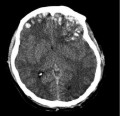Grad Student's Review of the Cognistat Exam

Brief History of Cognistat
In the world of psychology there are countless tests available to test a person’s level of cognitive functioning. One of the most widely known examinations with the ability to quickly assess a person’s cognitive capabilities is the Cognistat. The Cognistat was originally named the Neurobehavioral Cognitive Status Examination, or NCSE (Gupta & Kumar, 2009). This paper will outline the Cognistat test by discussing how the test was developed, what the test measures, what populations the test can be used for, current research on the test, and my personal evaluation of the exam.
The Cognistat exam is a standardized test normed on three population groups. The first population was a group of 60 nonprofessional members of a medical staff ranging from 20 to 66 years old; these people were screened before the testing and consisted of people with positive medical or neurological problems. The second population was a geriatric group made up of 59 individuals with a mean age of 77; and the third group was a group of 30 neurological patients with a mean age of 54 who had documented brain lesions (Kiernan, Mueller, & Langston, 1995). Since the original manual was written other groups have done further studies with different populations.
What Does The Test Measure?
The Cognistat was originally designed to assess cognitive function in five areas: memory, language, construction, calculations, and reasoning (Kiernan, Mueller, & Langston, 1995). Throughout the test questions, the results also assess for the client’s level of orientation, consciousness, and attention. The manual does not specify a target population, but the adults in the norming populations ranged from 20 to 66 years old. The Cognistat also can be given very quickly averaging between 10 and 40 minutes, depending on the person’s cognitive abilities. The test is a screen and metric based test. This means that if a person passes the screen item, the section is done and the test administrator advances to the next section. It is believed that if the test taker answers the most difficult question (the first question) correctly, then there is no need to test the easier questions. Many sources, including the test manual itself state that the Cognistat was not developed to be a sole neuropsychological examination, but more of a tool to detect the areas of cognitive weakness (Doninger, Ehde, Bode, Knight, Bombardier, & Heinemann, 2006). The results can show where in the brain the person taking the test may have deficiencies.

Why Would This Test Be Useful?
If a test has the capability to determine where the cognitive deficiencies are at in an individual, the results can be very useful for any therapist, doctor, or any other type of clinician. Because of the fact the Cognistat is quick and easy to administer, it is a very useful tool for all types of clinicians. Many professions from therapists, to doctors, and clinicians in rehabilitation hospitals use this test to quickly assess the severity of a client’s cognitive deficiencies to either further the appropriate testing, or to set the client up with the proper treatment for their specific injuries (Kiernan, Mueller, & Langston, 1995). The test is used with substance dependent populations, to assess the decline in cognitive ability in the elderly, brain injured clients, and other populations. This test however would not be a good choice for small children, blind people, or a person who does not speak and understand the given test languages (the test is available in several languages already).
Validity and Reliability
Concerning the validity and reliability of the test, although most sources will agree the Cognistat is a good diagnostic tool, some sources state that the test is not a good test because it does not even assess the reliability scores (Kiernan, Mueller, & Langston, 1995). The authors of the Cognistat state “the standard measurements of test-retest reliability are not appropriate for this scale due to the relative lack of variability in performance in the normal population which may lead to misleading reliability coefficients,” (Kiernan, Mueller, Langston, & Van Dyke, 1987). The authors also state that “split half reliability is statistically inappropriate due to the limited number of items on the scale,” (Kiernan, et. Al., 1987).
In the past I have not only taken the test but I have also given the test to clients. However, during my training on the test itself, my professor did not go over in depth what was going on with the test currently, nor did he go over why the test had no test/retest or split half reliability statistics. The test always has interested me and I wanted to learn more about it. Through my research I discovered although the test is widely used around the world, some people think it is not a substantial tool because it does lack the reliability and validity statistics. Although the test originators did not believe the test/retest statistics were reliable because of the differentiation between the populations’ performances or that the statistics could be biased because of the small number of items on the scales, I thought the statistics needed to be there because it is crucial to assess the reliability of the test.
I believe there are possible ways to test the reliability and validity among different populations. For example, a clinician or a graduate student could set up a study using a control group of people from the “normal” population and a group of neurologically challenged individuals and examine the results. Or it would also be possible to find certain populations and determine the reliability among those populations. If the test does not fit certain populations, then why is there no second form of the test? I know the test creators have different language versions, but why not make two versions of the same test. For example there could be a test “A” and a variation called test “B”. A person could then use the statistical data from the two tests to see if there is high validity and reliability amongst a certain population
Poll of the Day:
If you had to choose, which group of populations would you like to see this test's reliability tested with?
Current Studies
I was amazed when I continued my research because I found there were people out there who thought like me in regard to testing different populations. One article described a study done on two independent samples: group one was a group of 134 patients admitted to an inpatient rehabilitation facility for the treatment of traumatic brain injuries and the second was a group of 186 community residing adults who had sustained a traumatic brain injury (Doninger, Ehde, Bode, Knight, Bombardier, & Heinemann, 2006). The study was done to try to see how to calibrate item responses by using different rating scale measurement strategies to determine the Cognistat’s ability to distinguish meaningful levels of cognitive impairment between inpatient patients with traumatic brain injuries without patient individuals with traumatic brain injuries (Doninger, et. al., 2006). The group also wanted to look at psychometric properties to determine if the Cognistat served as a tool for characterizing different types of cognitive impairment (Doninger, et. al, 2006).After administering the Cognistat to both groups and calculating the reliability and validity, the group’s results prove the Cognistat can reliably differentiate between inpatient and outpatient traumatic brain injury settings but they offer a caution: “we caution clinicians against using this measure as an efficient means of generating a profile of cognitive strengths and impairments that may influence rehabilitation and reintegration into the community,” (Doninger, et. Al., 2006).
Generally speaking, the Doniger, et. al., study proves what the authors of the Cognistat state in the manual. The writers stated the test was a good indicator of where the cognitive deficiencies were but that the test should not be the only test used to diagnose or treat a brain injury. A clinician should always use a secondary test or evaluation as well to compliment the findings of the Cognistat.
Controversy Between Use and Misuse
When it comes to what the research showed about uses and misuses of the Cognistat, the studies were unbalanced. Many articles stated the Cognistat is a very useful tool in determining the extent of a person’s cognitive abilities (Gupta & Kumar, 2009); (Doninger, et. Al., 2006); & (Kiernan, et. Al., 1987). The test can be used with a variety of languages and different settings that deal with brain injuries (Kiernan, et. Al., 1987). However, concerning the studies regarding the misuses of the test there was not much information. The only negative aspect that came out of my research was the simple fact that the Cognistat should not be used by itself, but in conjunction with a mental status exam and other psychological batteries (Gupta and Kumar, 2009); (Doninger, et. Al., 2006); & (Kiernan, et. Al., 1987). The only other instances in which the test could be abused are if it was given to someone who didn’t understand the language the test is in; if the test administrator did not administer the test correctly (i.e. skipping questions, giving credit for no credit answers, or any other biased behaviors); or if the test was not given in a distraction free setting that allowed outside influence on the test taker’s answers.
Cultural Considerations
Concerning the Cognistat’s reliability and validity with different cultures I found one very useful article. Not only did the article state the Cognistat does have high reliability and validity in different languages but the study also states that the test is a good tool to measure cognition among culturally diverse people when the correct version of the test is used. In this specific article, the author’s particular focus was on the Indian population from India. In 2009, Gupta and Kumar wrote the Cognistat’s concurrent validity with other standardized neurological tests proves it is a solid tool to use in assessing a patient’s cognitive abilities (Gupta & Kumar, 2009). This article was interesting because not only did it praise the Cognistat’s reliability but it also was one of the few articles that described some of the changes in the test items for a specific culture.
It is very important that any given test be appropriate for the culture of the client. If the test is based on items that a specific culture is not sensitive to, it is possible the questions may be answered correctly according to their language and culture, but scored as a wrong answer by the clinician. The cultural misunderstanding can lead to all sorts of misdiagnosis, improper treatment, and many other negative aspects. The Gupta and Kumar article is important because it shows exactly how the test was altered to fit the Indian culture. For example, the test writers omitted the screen and metric approach of the original test because newer studies have found this method yields high false positives (Gupta & Kumar, 2009). To do this, all of the screening questions from the original Cognistat were eliminated and only the metric questions were administered. Also, a sub-test for evaluating a person’s immediate visual memory was added; as well as a detailed evaluation of spoken language (Gupta & Kumar, 2009). The detailed evaluation provides a checklist that contains a description of some of the commonly found problems that can occur from traumatic brain injuries and lesions concerning spoken language patterns (Gupta & Kumar, 2009). This is a very useful addition to the Cognistat and I think adding a chart of common speech problems due to brain injuries would be a good tool for every version of the Cognistat. The Gupta and Kumar study even broke down their sample into how much time had elapsed since the brain injury, which I think should also be a factor in every version of the test. The amount of time that has elapsed between the injury and the testing could significantly alter how well or how bad a person could score on the test.
Drawing My Own Conclusions
After doing hours of reading on the Cognistat, the test’s multiple versions, how the test is used, and various studies done testing the reliability and validity of the test, I believe the Cognistat is a solid test that should be used for a brief screening to determine a person’s current level of cognitive functioning. The test appears to be effective with various types of populations and cultures, as long as the appropriate language version is used and the test administrator scores the test correctly. I believe that if I was going to study the efficiency of the Cognistat myself I would do more norming studies comparing different groups of people depending on how much time had elapsed since the traumatic brain injury (if there was a known injury). All in all though I believe the Cognistat is a great testing tool but the tests validity could be explored more.
References
Doninger, N., Ehde, D., Bode, R., Knight, K., Bombardier, C., & Heinemann, A. (2006). Measurement properties of the neurobehavioral cognitive status examination (Cognistat) in traumatic brain injury rehabilitation. Rehabilitation Psychology, 281-288.
Gupta, A., & Kumar, N. (2009). Indian adaptation of the Cognistat: Psychometric properties of a cognitive screening tool for patients of traumatic brain injury. Indian Journal of Neurotrauma, 6(2), 123-32.
Kiernan, R., Mueller, J., Langston, W. & Van Dyke, C. (1987). The Neurobehavioral Cognitive Status Examination: A brief but differentiated approach to cognitive assessment. Annals of Internal Medicine, 401-485.
Kiernan, R., Mueller, J., & Langston, J. (1995) Cognistat (The Neurobehavioral Cognitive Status Examination). Retrieved December 4, 2010 from Mental Measurements yearbook database.








